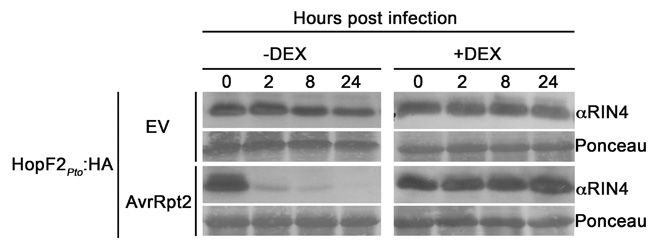The type III effector HopF2Pto targets Arabidopsis RIN4 protein to promote Pseudomonas syringae virulence
Wilton M, Subramaniam R, Elmore J, Felsensteiner C, Coaker G, Desveaux D
Proc. Natl. Acad. Sci. U.S.A. 2010 Feb;107(5):2349-54
PubMed PMID: 20133879
Abstract
Plant immunity can be induced by two major classes of pathogen-associated molecules. Pathogen- or microbe-associated molecular patterns (PAMPs or MAMPs) are conserved molecular components of microbes that serve as “non-self” features to induce PAMP-triggered immunity (PTI). Pathogen effector proteins used to promote virulence can also be recognized as “non-self” features or induce a “modified-self” state that can induce effector-triggered immunity (ETI). The Arabidopsis protein RIN4 plays an important role in both branches of plant immunity. Three unrelated type III secretion effector (TTSE) proteins from the phytopathogen Pseudomonas syringae, AvrRpm1, AvrRpt2, and AvrB, target RIN4, resulting in ETI that effectively restricts pathogen growth. However, no pathogenic advantage has been demonstrated for RIN4 manipulation by these TTSEs. Here, we show that the TTSE HopF2(Pto) also targets Arabidopsis RIN4. Transgenic plants conditionally expressing HopF2(Pto) were compromised for AvrRpt2-induced RIN4 modification and associated ETI. HopF2(Pto) interfered with AvrRpt2-induced RIN4 modification in vitro but not with AvrRpt2 activation, suggestive of RIN4 targeting by HopF2(Pto). In support of this hypothesis, HopF2 (Pto) interacted with RIN4 in vitro and in vivo. Unlike AvrRpm1, AvrRpt2, and AvrB, HopF2(Pto) did not induce ETI and instead promoted P. syringae growth in Arabidopsis. This virulence activity was not observed in plants genetically lacking RIN4. These data provide evidence that RIN4 is a major virulence target of HopF2(Pto) and that a pathogenic advantage can be conveyed by TTSEs that target RIN4.

